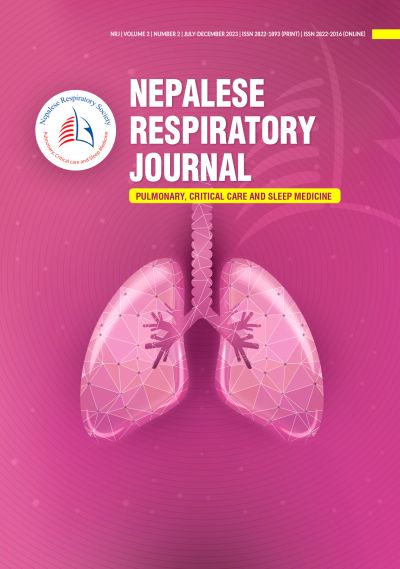Experience of clinicians with dual bronchodilator therapy in COPD (EXPAND) in Nepal
DOI:
https://doi.org/10.3126/nrj.v2i2.69201Keywords:
Chronic Obstructive Pulmonary Disease, Bronchodilators, Inhaler Techniques, Formoterol, TiotopriumAbstract
Introduction: Combination of bronchodilators, particularly long-acting muscarinic antagonists (LAMAs) and long-acting β2 agonists (LABAs) have become the mainstay of pharmacological therapy for COPD. COPD is now a common non communicable disease in Nepal.
Objective: The study evaluated the current perception and experience of the clinicians in Nepal on diagnosis and management of COPD with focus on use of dual bronchodilator therapy.
Method: This cross-sectional, observational survey evaluated experiences of clinicians (n=96; pulmonologist-13, physician-57, general practitioner-26) in Nepal on diagnosis, management trends, and current perceptions on the use of dual bronchodilator therapy in COPD management.
Result: 93% of clinicians were practising in an urban setting for an average of 10 years and an average of 35% of their patients are of COPD. 61% of clinicians use mMRC with (34%) or without (27%) CAT score. 92% of clinicians perceived that most of their patients had 1 (32%) or >1 (59%) exacerbation/year. 54% of clinicians performed spirometry on all their patients with suspected COPD. 49% of clinicians measured blood EOS in their patients with severe COPD before adding ICS. 93% of clinicians preferred dual therapy (separate inhalers or a combination) for their COPD patients, but 83% of clinicians preferred LABA + LAMA in a single inhaler over inhalers given separately. 57% of clinicians preferred LABA + LAMA and 82% preferred the Tiotropium + Formoterol combination. 81% of clinicians stepped up or stepped down their treatment. 56% of patients were taking LABA + LAMA + ICS and 55% of clinicians co-prescribed ICS + LABA with LABA + LAMA. 80% of clinicians checked the inhalation technique at every visit and an average of 54% of their COPD patients were adherent (>80%) to the prescribed inhalation therapy. 78% of clinicians felt that dryness of mouth was the most common side effect of LABA + LAMA. 94% of clinicians believed that managing COPD better could improve cardiovascular outcomes in their patients with coexistent COPD.
Conclusion: In the EXPAND survey, Formoterol + Tiotropium was preferred by most clinicians in Nepal amongst the LABA + LAMA combination. There is a good scope for improvement in the utilization of tools like spirometry, mMRC, CAT, and blood EOS in the daily practice of clinicians in Nepal.
Downloads
Downloads
Published
How to Cite
Issue
Section
License
© Nepalese Respiratory Society

This article is licensed under a Creative Commons Attribution 4.0 International License.




